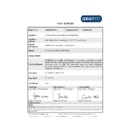Harman Kardon ESQUIRE (serv.man3) EMC - CB Certificate ▷ View online
Report No.:
EM201300418-1
Application No.:
ZJ00031163
Page 41 of 58
Middle Channels:
Highest Channels:
Report No.:
EM201300418-1
Application No.:
ZJ00031163
Page 42 of 58
4.5 HOPPING CHANNEL SEQUENCE
4.5.1 LIMITS
EN 300 328 clause 4.3.4.3.2
4.5.2 TEST PROCEDURE
Remove the antenna from the EUT and then connect a low attenuation cable from the antenna port
to the spectrum.
Set the spectrum analyzer: RBW = 100 kHz. VBW ≥ 100 kHz. Sweep = auto; Detector Function =
Peak. Trace = Max hold.
Allow the trace to stabilize. It may prove necessary to break the span up to sections. in order to
clearly show all of the hopping frequencies. The limit is specified in one of the subparagraphs of
this Section.
Set the spectrum analyzer: start frequency = 2400MHz. stop frequency = 2483.5MHz. Submit the
test result graph.
4.5.3 TEST SETUP
EN 300 328 clause 4.3.4.3.2
4.5.2 TEST PROCEDURE
Remove the antenna from the EUT and then connect a low attenuation cable from the antenna port
to the spectrum.
Set the spectrum analyzer: RBW = 100 kHz. VBW ≥ 100 kHz. Sweep = auto; Detector Function =
Peak. Trace = Max hold.
Allow the trace to stabilize. It may prove necessary to break the span up to sections. in order to
clearly show all of the hopping frequencies. The limit is specified in one of the subparagraphs of
this Section.
Set the spectrum analyzer: start frequency = 2400MHz. stop frequency = 2483.5MHz. Submit the
test result graph.
4.5.3 TEST SETUP
4.5.4 TEST RESULTS
Antenna
EUT
Attenuator
Receiver
Report No.:
EM201300418-1
Application No.:
ZJ00031163
Page 43 of 58
Total channels are 79 channels
Report No.:
EM201300418-1
Application No.:
ZJ00031163
Page 44 of 58
4.6 MEDIUM ACCESS PROTOCOL
4.6.1 DEFINITION
EN 300 328 V1.7.1 4.5.3: A medium access protocol is a mechanism designed to facilitate
spectrum sharing with other devices in a wireless network.
4.6.2 REQUIREMENT
A medium access protocol shall be implemented by the equipment.
On the basis of the latest list of harmonized standards under the R&TTE Directive 1999/5/EC
which was published on October 23, 2012 in Official Journal C321 contains the following
(mandatory) guidance: The efficiency of the various sharing mechanisms can be assessed
using the appropriate clauses of EN 300328 version 1.8.1.”
In addition, this requirement does not apply for equipment with a maximum declared RF
Output power level of less than 10 dBm e.i.r.p. or for equipment when operating in a mode
where the RF Output power is less than 10 dBm e.i.r.p.
Adaptive Frequency Hopping equipment is allowed to operate in a non-adaptive mode
providing it complies with the requirements applicable to non-adaptive frequency hopping
equipment.
Adaptive Frequency Hopping equipment is allowed to have Short Control Signalling
Transmissions (e.g. ACK/NACK signals, etc.) without sensing the frequency for the presence
of other signals. See clause 4.3.1.6.3.
Adaptive Frequency Hopping (AFH) equipment uses a Detect And Avoid (DAA) mechanism
which allows an equipment to adapt to its environment by identifying frequencies that are
being used by other equipment.
Adaptive Frequency Hopping systems shall implement either of the DAA mechanisms
provided in clauses 4.3.1.6.1 or 4.3.1.6.2.
4.6.3 FREQUENCY HOPPING SYSTEM
This transmitter device is frequency hopping device, and complies with EN 300 328 4.3.5
standard.
This device uses Bluetooth radio which operates in 2400~2483.5MHz band. Bluetooth uses a
radio technology called frequency-hopping spread spectrum, which chops up the data being
sent and transmits chunks of it on up to 79 bands(1MHz each; centered from 2402~2480MHz)
in the range 2400~2483.5MHz. The transmitter switches hop frequencies 1600 times per
second to assure a high degree of data security. All Bluetooth devices participating in a given
Click on the first or last page to see other ESQUIRE (serv.man3) service manuals if exist.

